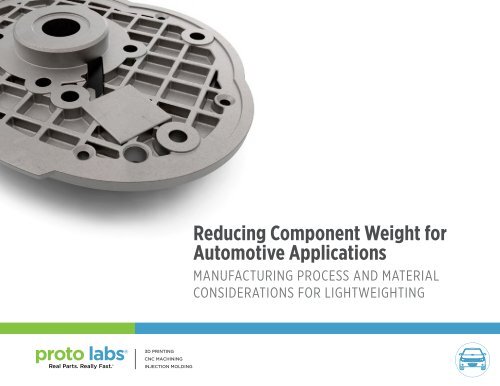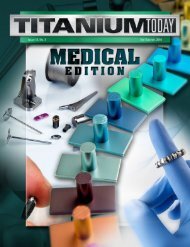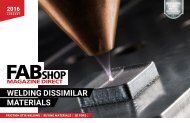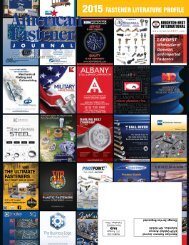Reducing Component Weight for Automotive Applications
1Uz2lLA
1Uz2lLA
Create successful ePaper yourself
Turn your PDF publications into a flip-book with our unique Google optimized e-Paper software.
<strong>Reducing</strong> <strong>Component</strong> <strong>Weight</strong> <strong>for</strong><br />
<strong>Automotive</strong> <strong>Applications</strong><br />
MANUFACTURING PROCESS AND MATERIAL<br />
CONSIDERATIONS FOR LIGHTWEIGHTING
<strong>Reducing</strong> <strong>Component</strong> <strong>Weight</strong> <strong>for</strong> <strong>Automotive</strong> <strong>Applications</strong><br />
Smoggy cities, rollercoaster gas prices, environmental<br />
concerns over fracking and offshore drilling — there<br />
are many reasons to increase fuel efficiency in both<br />
passenger and commercial vehicles. One of the<br />
best ways to do this is by reducing vehicle weight.<br />
Lighter cars mean consumers use less fuel, and less<br />
fuel means cleaner air and reduced dependence<br />
on irreplaceable fossil fuels. Simply put, vehicle<br />
lightweighting makes good sense.<br />
The U.S. government thinks so as well. Since 1975,<br />
the Department of Transportation has imposed<br />
strict Corporate Average Fuel Economy (CAFE)<br />
standards on automakers, telling them to reduce fuel<br />
consumption or face stiff penalties. The next round<br />
of efficiency bar-raising is just around the corner,<br />
and by 2025, cars and light trucks are expected to<br />
boast an “average” fuel economy of 54.5 mpg.<br />
The calculations behind those standards are complex,<br />
making interpretation somewhat subjective, yet the<br />
fact remains that automotive manufacturers and their<br />
suppliers will be fighting a continuous uphill battle to<br />
design and produce lighter, more efficient automotive<br />
components <strong>for</strong> decades to come.<br />
All these regulatory and market-driven redesign<br />
initiatives are creating a perfect storm of product<br />
development activity <strong>for</strong> automotive suppliers. Even<br />
in the commercial sector, countless opportunities<br />
exist to simplify designs, reduce weight and use less<br />
material, all of which benefits consumers and the<br />
planet alike.<br />
A move to lighter weight products and components<br />
often begins with prototyping, where material and<br />
manufacturing process selection is paramount.<br />
© Proto Labs 1999–2016 Proto Labs, Inc., 5540 Pioneer Creek Dr., Maple Plain, MN 55359 USA | 877.479.3680<br />
2
<strong>Reducing</strong> <strong>Component</strong> <strong>Weight</strong> <strong>for</strong> <strong>Automotive</strong> <strong>Applications</strong><br />
A Move to Magnesium<br />
One thing that should be remembered be<strong>for</strong>e<br />
embarking on any lightweighting project is to take<br />
small bites. Unless you’re creating a fuel-efficient<br />
redesign of the transmission housing <strong>for</strong> an<br />
18-wheeler, you’re not going to remove 50 pounds<br />
of weight from any single part. Instead, shaving<br />
ounces and even fractions of ounces out of each<br />
component that makes up a passenger vehicle is the<br />
clear path to CAFE compliance. The rear view mirror<br />
used in passenger cars, <strong>for</strong> example, was once heavy<br />
enough to pound a nail. Today, most rear view mirrors<br />
are made of a magnesium frame and a plastic shell,<br />
yet retain the same strength and functionality as<br />
their corpulent predecessors. The trick is to develop<br />
products that fulfill cost and duty requirements but<br />
use alternate materials and clever designs to<br />
reduce weight.<br />
Rear view mirror with magnesium frame and a plastic shell.<br />
Fortunately <strong>for</strong> designers and engineers, today’s<br />
array of prototyping materials and advanced<br />
manufacturing technologies mean never be<strong>for</strong>e<br />
possible opportunities <strong>for</strong> iterative, even parallel-path<br />
design testing. For example, suppose you’ve been<br />
tasked with lightweighting the headlight bezel <strong>for</strong><br />
a 2019 model year reintroduction of the four-door<br />
Studebaker Lark. When you begin to explore material<br />
selection, magnesium might be a good place to start.<br />
With a density of 106 lb. per cubic foot, magnesium<br />
is the lightest of all structural metals, and has the<br />
highest strength-to-weight ratio as well. It carries a<br />
proven track record in the automotive, aerospace,<br />
medical, and electronics industries, and is used in<br />
everything from fuel tanks to gearboxes. And because<br />
magnesium is one of the most abundant minerals<br />
in the human body, it is not only biocompatible<br />
but also biodegradable, so it is a logical choice <strong>for</strong><br />
self-dissolving screws, pins and other implants<br />
requiring greater strength than those made of<br />
biodegradable polymers.<br />
Magnesium is routinely milled into a variety of<br />
prototype parts. Compared to aluminum, the<br />
lightweighting runner-up, it is more expensive<br />
per pound, but that cost delta is offset somewhat<br />
by magnesium’s 33-percent lighter weight and<br />
comparable strength. It’s also easily machined<br />
although some care must be taken to control fine<br />
chips and metal particles, as these can be flammable<br />
in oxygen-rich environments.<br />
For those concerned over fires with magnesium<br />
components in the field, don’t be — magnesium<br />
is everywhere. The Volkswagen Beetle sported<br />
a magnesium alloy engine block <strong>for</strong> decades,<br />
and BMW started using magnesium <strong>for</strong> its N52<br />
BMW started using magnesium <strong>for</strong> its N52 six-cylinder<br />
crankcases and cylinder head covers in 2005.<br />
six-cylinder crankcases and cylinder head covers in<br />
2005. The AZ31 and AZ91 grades of magnesium<br />
alloy used at Proto Labs are even weldable, and have<br />
melting points of roughly 900-degrees F (482 C).<br />
Unless you’re designing a lightweight furnace liner,<br />
magnesium is an excellent choice <strong>for</strong> many<br />
different components.<br />
The Big Three are also big on magnesium. In 2006,<br />
General Motors began using die cast magnesium<br />
<strong>for</strong> the engine cradle in its Z06 Corvette, shaving<br />
12 pounds off the old design. Ford Motor Company’s<br />
started using magnesium in the liftgate of the 2010<br />
Lincoln MKT, and the third row passenger seats <strong>for</strong><br />
the 2011 Ford Explorer. In that same year, Chrysler<br />
Group introduced a magnesium instrument panel<br />
<strong>for</strong> its Jeep Grand Cherokee, helping the vehicle<br />
achieve highway fuel economy of 23 mpg. In<br />
summary, domestic and <strong>for</strong>eign automakers alike<br />
are turning to magnesium <strong>for</strong> its strength, light<br />
weight and — because it can be extracted from<br />
seawater — its abundant supply.<br />
© Proto Labs 1999–2016 Proto Labs, Inc., 5540 Pioneer Creek Dr., Maple Plain, MN 55359 USA | 877.479.3680<br />
3
<strong>Reducing</strong> <strong>Component</strong> <strong>Weight</strong> <strong>for</strong> <strong>Automotive</strong> <strong>Applications</strong><br />
Plastic Alternatives<br />
Magnesium and aluminum are excellent alternatives to steel <strong>for</strong> lightweighting, yet thermoplastic and thermoset materials are robust possibilities as well. An extensive<br />
selection of glass-, metal- or ceramic-filled polymers as well as liquid silicone rubber (LSR) can also be used to replace metal parts, thus reducing product cost and<br />
weight while improving durability.<br />
• Polypropylene (PP) is a flexible, fatigueresistant<br />
family of thermoplastics commonly<br />
used in automotive interiors, battery cases, boat<br />
hulls, prosthetics, and other products requiring<br />
toughness and light weight. The different grades<br />
of polypropylenes are grouped as homopolymers,<br />
impact copolymers, or random copolymers, with the<br />
latter two considered engineering-grade materials,<br />
offering superior strength-to-weight ratios and<br />
good impact resistance even at cold temperatures.<br />
All polypropylenes are heat-resistant, with melting<br />
points in the neighborhood of 300-degrees F<br />
(149 C). They’re also microwavable, and molded<br />
parts can be left translucent or colored, making<br />
PP a favorite in food storage containers and other<br />
types of lightweight packaging.<br />
• Polyethylene is offered in both high-density (HDPE)<br />
and low-density (LDPE) versions. HDPE has uses<br />
and mechanical properties similar to polypropylene,<br />
but is more rigid and offers greater resistance to<br />
warping. Because of its low cost and relatively high<br />
strength, it’s often used in underground pipes, water<br />
tanks and chemical storage containers. HDPE’s<br />
lower density, more flexible counterpart LDPE sees<br />
use in squeeze bottles, plastic wrap and playground<br />
slides. Both materials are suitable <strong>for</strong> use where<br />
toughness and low weight is needed — the glove<br />
box <strong>for</strong> a Studebaker, perhaps, or a cold air intake.<br />
• ABS is another thermoplastic with exceptional<br />
impact resistance and toughness. It is a lightweight<br />
alternative to metal in dashboard trim, electronics<br />
enclosures, hubcap covers and other such<br />
automotive applications. Injection-molded ABS is<br />
also available in either flame-retardant or antistatic<br />
grades in a rainbow of colors, opening the door to a<br />
staggering number of lightweight consumer, medical<br />
and electronics products. Chrome-plated ABS<br />
hubcaps are used on a large number of passenger<br />
cars to reduce vehicle weight, as are ABS grills and<br />
ABS fender flares. Finally, the chassis of the world’s<br />
first 3D-printed automobile — the STRATI — produced<br />
onsite during the 2014 International Manufacturing<br />
Technology Show, was made of carbon-fiber<br />
rein<strong>for</strong>ced ABS. It weighs just 1,100 pounds.<br />
• Polycarbonate (PC) is very thermo<strong>for</strong>mable, and<br />
is frequently shaped into see-through architectural<br />
panels, eyeglass lenses, industrial computer screens,<br />
and other products where glass is unsuitable due<br />
to weight or breakage concerns. It has 250 times<br />
the impact resistance but only half the weight of<br />
regular glass, which is why “bulletproof glass”<br />
and aircraft windows are actually made of<br />
polycarbonate or its slightly more flexible cousin,<br />
acrylic. On the additive manufacturing side of the<br />
house, Proto Labs offers 10-percent glass-filled<br />
polycarbonate-mimic Accura 60 plastic from<br />
3D Systems <strong>for</strong> functional prototypes with<br />
properties similar to commercial-grade PC,<br />
and Accura 5530 or ceramic-filled DSM Somos<br />
NanoTool <strong>for</strong> high-temp aerospace and automotive<br />
applications. Similar grades of PC are available<br />
<strong>for</strong> machining or injection molding.<br />
Optical LSR used in place of glass <strong>for</strong> lighting<br />
applications in vehicles.<br />
A clear automotive lens built by stereolithography.<br />
© Proto Labs 1999–2016 Proto Labs, Inc., 5540 Pioneer Creek Dr., Maple Plain, MN 55359 USA | 877.479.3680<br />
4
<strong>Reducing</strong> <strong>Component</strong> <strong>Weight</strong> <strong>for</strong> <strong>Automotive</strong> <strong>Applications</strong><br />
• Nylon is also frequently filled with mineral or glass<br />
fibers to improve stiffness-to-weight ratios and<br />
improve mechanical properties. This makes it one of<br />
the strongest plastics available at Proto Labs and —<br />
because nylon is self-lubricating, thermally stable<br />
and very wear-resistant — is an excellent candidate<br />
<strong>for</strong> sprockets, fan blades, gears, latches, manifolds<br />
and bearing surfaces. It’s also very light, with<br />
15-percent the weight of steel and 40-percent of<br />
aluminum. Proto Labs offers selective laser sintering<br />
(SLS) of several engineering-grade nylons, which<br />
can be used <strong>for</strong> functional testing of prototypes<br />
prior to machining or injection molding. One of<br />
these is Nylon 11, a material that works well <strong>for</strong> living<br />
hinge designs as used in hose and wire clips, washer<br />
fluid caps and other automobile components.<br />
• Acetal, more commonly called by its trade name<br />
Delrin, is a regular go-to material <strong>for</strong> machined<br />
prototypes. It is strong and stiff without the need<br />
<strong>for</strong> nylon’s glass-fiber rein<strong>for</strong>cement (although glass<br />
is sometimes used to increase Delrin’s stiffness<br />
and creep resistance), and is regularly called upon<br />
to replace precision metal parts in a range of<br />
industrial and consumer products: electrical and<br />
fuel system components, power transmission parts<br />
such as gears, bushings, and bearings, and other<br />
high-per<strong>for</strong>mance parts can be milled or injection<br />
molded from different grades of acetal copolymer<br />
or homopolymers stocked at Proto Labs.<br />
• Liquid silicone rubber, or LSR, is a surprising but<br />
versatile material <strong>for</strong> many molding applications.<br />
It starts out as a two-part thermoset compound,<br />
which is mixed at low temperatures and then<br />
injected into a heated mold. Upon curing, LSR<br />
becomes strong yet flexible, and is suitable <strong>for</strong><br />
gaskets, lenses, connectors, and other parts that<br />
require excellent thermal, chemical, and electricalresistance.<br />
Wiring harnesses, panel buttons, spark<br />
plug boots — these are but of few of the places LSR<br />
can be found in modern vehicles.<br />
That’s a lot of plastic. There are many more types<br />
available, and many can reduce the weight of<br />
products currently being made of steel or aluminum.<br />
A new material at Proto Labs worthy of mention is<br />
CoolPoly, a unique polymer moldable in hardness<br />
levels ranging from Shore A 40 (soft like an eraser) to<br />
Shore D 80 (hard like a bowling ball). It was created<br />
as a replacement <strong>for</strong> heatsinks, lighting shrouds and<br />
other thermally conductive parts normally made of<br />
aluminum, reducing the weight of these components<br />
by 50-percent or more. This presents huge potential<br />
<strong>for</strong> lightweighting in electric vehicles, consumer<br />
electronics, lighting systems … the list goes on.<br />
LIGHTWEIGHTING<br />
MATERIAL OPTIONS<br />
MAGNESIUM<br />
ALUMINUM<br />
LIQUID SILICONE<br />
RUBBER<br />
POLYPROPYLENE<br />
POLYETHYLENE<br />
ABS<br />
POLYCARBONATE<br />
NYLON<br />
ACETAL<br />
© Proto Labs 1999–2016 Proto Labs, Inc., 5540 Pioneer Creek Dr., Maple Plain, MN 55359 USA | 877.479.3680<br />
5
<strong>Reducing</strong> <strong>Component</strong> <strong>Weight</strong> <strong>for</strong> <strong>Automotive</strong> <strong>Applications</strong><br />
Weighing the Manufacturing Options<br />
Despite the flexibility in material options, it’s a good<br />
idea to understand what material peg fits into which<br />
manufacturing hole. Machined prototypes were once<br />
produced on hand-cranked milling machines and<br />
engine lathes. They were largely made of steel, brass,<br />
or aluminum and took weeks to deliver. Proto Labs<br />
has automated that same basic process to the<br />
extent that electronic part designs can literally be<br />
uploaded one day and delivered the next, and made<br />
from nearly every material previously mentioned.<br />
Proto Labs’ CNC machining centers mill prototypes<br />
from solid blocks of metal and plastic roughly the<br />
size of a thick encyclopedia, and lathes with live<br />
tooling cut parts about as large as a flower vase.<br />
Both processes hold tolerances to +/- 0.005 in.<br />
(0.13mm) or better, depending on part geometry.<br />
A growing method to rapidly manufacture<br />
magnesium parts is through injection molding (also<br />
known as thixomolding). Here, chips of magnesium<br />
feedstock are loaded into the hopper of a molding<br />
press. Heat and agitation are then applied, thus<br />
bringing the magnesium payload to a semisolid<br />
state, whereupon it is “shot” under pressure into<br />
a mold cavity via a feeder screw. The result is that<br />
fully functional magnesium components can be<br />
produced in low volumes at a fraction the cost<br />
of “production-tooled” parts. Better yet, it’s fast —<br />
compared to die casting, the traditional high-volume,<br />
long lead-time solution <strong>for</strong> aluminum and magnesium<br />
components, magnesium injection molded parts from<br />
Proto Labs can be shipped in 15 days or less from<br />
order acceptance.<br />
Many manufacturing engineers associate magnesium<br />
with die casting, as this has long been the traditional,<br />
high-volume method of <strong>for</strong>ming this ubiquitous<br />
metal. Yet magnesium injection molding offers a<br />
number of distinct advantages over its more mature<br />
counterpart. Thixomolding is essentially a “cold”<br />
process, operating just short of magnesium’s melting<br />
point. Because of this, there is less shrinkage and<br />
warp compared to die-cast parts, and the mechanical<br />
properties of thixomolded parts are generally<br />
better as well. The cooler process also requires<br />
less sophisticated tooling, as there is little need <strong>for</strong><br />
cooling channels. And since the magnesium slurry<br />
is fed into the mold at very high pressure — in some<br />
cases twice that of die casting — very fine part details<br />
are produced. All things considered, thixomolding is<br />
the clear choice <strong>for</strong> many prototyped or low-volume<br />
magnesium components.<br />
Feedstock used in magnesium injection molding to create<br />
98-percent dense magnesium parts.<br />
Another mature prototyping process is<br />
stereolithography (SL), the grandfather of all<br />
additive manufacturing technologies. Proto Labs<br />
uses SL to print parts from nine grades of polymer<br />
across three primary groups: ABS, polycarbonate<br />
and polypropylene. It’s important to point out that<br />
these materials mimic plastics and are not rated <strong>for</strong><br />
functional product use. SL does, however, produce<br />
highly accurate prototypes, and is a logical first<br />
step <strong>for</strong> an initial “touch and feel” of lightweighted<br />
concept parts. And <strong>for</strong> testing the <strong>for</strong>m and fit of<br />
products destined <strong>for</strong> die casting, Proto Labs offers<br />
SLArmor, a nickel-plated, ceramic-filled additive<br />
material that is very light yet still strong enough<br />
to pinch-hit <strong>for</strong> metal in certain cases, and an ideal<br />
solution <strong>for</strong> many lightweighting applications.<br />
Magnesium injection molded parts be<strong>for</strong>e overflow<br />
gating material is removed via CNC machining.<br />
© Proto Labs 1999–2016 Proto Labs, Inc., 5540 Pioneer Creek Dr., Maple Plain, MN 55359 USA | 877.479.3680<br />
6
<strong>Reducing</strong> <strong>Component</strong> <strong>Weight</strong> <strong>for</strong> <strong>Automotive</strong> <strong>Applications</strong><br />
Next on the additive manufacturing list is selective<br />
laser sintering, which is limited to four types<br />
of engineering-grade nylon materials at Proto Labs,<br />
two of which are rein<strong>for</strong>ced <strong>for</strong> high-heat applications<br />
and greater structural integrity. Like all additive<br />
processes at Proto Labs, SLS employs a laser to<br />
draw each part layer. Part features are somewhat<br />
less accurate than those produced by SL, but still<br />
plenty good <strong>for</strong> functional testing. Of all the plastic<br />
materials available at Proto Labs, glass-filled nylon is<br />
one of the most popular materials with automotive<br />
manufacturers, largely due its low cost and<br />
toughness, although glass-filled polycarbonate comes<br />
in a close second. Because of this, SL and SLS are<br />
both very suitable <strong>for</strong> prototyping lightweight parts.<br />
Another increasingly used additive manufacturing<br />
process offered is DMLS, or direct metal laser<br />
sintering. DMLS melts layers of metal powder, as thin<br />
as 0.0008 in. (20 microns) at Proto Labs, to create<br />
complex, 98-percent dense part shapes that are often<br />
impossible to manufacture otherwise. It is highly<br />
accurate with tolerances of +/- 0.003 in. plus an<br />
additional 0.001 in./in. that are typically achieved<br />
on well-designed parts.<br />
At Proto Labs, DMLS works with aluminum<br />
and titanium, so is an obvious contender <strong>for</strong><br />
manufacturing lightweight parts, but is also used<br />
with 316L and 17-4PH stainless steel, cobalt chrome<br />
DMLS can be used to build complex aluminum<br />
parts that are difficult to machine.<br />
alloy, and Inconel, super strong metals known <strong>for</strong><br />
their extreme heat resistance and durability rather<br />
than weight reduction. You might be wondering how<br />
an additive process that uses metals such as these<br />
has made its way into a lightweighting white paper.<br />
But here’s the thing: DMLS can fabricate metal parts<br />
that, until now, were nothing more than a designer’s<br />
fantasy. Parts more hollow than a chocolate Easter<br />
egg, Escher-like curves and spheres, ultra-thin walls<br />
and spider web-like lattices, consolidation of multipart<br />
assemblies into a single sintered component —<br />
these are a few of the lightweighting possibilities<br />
DMLS (as well as SL and SLS) can offer.<br />
Industrial-grade metal sintering allows <strong>for</strong> fully<br />
functional 3D printed metal parts.<br />
DMLS is slower than other additive processes,<br />
and more expensive — if your part design can be<br />
efficiently machined or molded, DMLS may not be<br />
the right manufacturing method. But <strong>for</strong> complex<br />
assemblies, improbable shapes, or parts where<br />
small amounts of superalloy go a long way, DMLS<br />
might be just the ticket to reduce part weight and<br />
cut manufacturing costs. Lastly, DMLS isn’t limited<br />
to prototype quantities — given a small, complex<br />
workpiece too difficult or expensive to manufacture<br />
via conventional methods, DMLS is often a viable<br />
alternative <strong>for</strong> low-volume production volumes<br />
in the thousands.<br />
© Proto Labs 1999–2016 Proto Labs, Inc., 5540 Pioneer Creek Dr., Maple Plain, MN 55359 USA | 877.479.3680<br />
7
<strong>Reducing</strong> <strong>Component</strong> <strong>Weight</strong> <strong>for</strong> <strong>Automotive</strong> <strong>Applications</strong><br />
Final Considerations<br />
Consider the water pump in our Studebaker redesign project. Glass-filled polycarbonate would make a strong, lightweight impeller, the brass drain plugs could easily<br />
be replaced by ABS or polypropylene plastic, and nickel-plated, ceramic-filled NanoTool material might be used <strong>for</strong> the backplate. In each of these cases, you could<br />
use SL to 3D print various design iterations <strong>for</strong> <strong>for</strong>m and fit testing, followed by having a dozen or so prototypes machined <strong>for</strong> functional testing, and then easily move<br />
to several thousand injection-molded parts. While you’re at it, don’t <strong>for</strong>get to replace the cast iron pump housing with one made of magnesium.<br />
Sorting through all the different possibilities is one of the biggest challenges with lightweighting. That’s because improvements to product design in the automotive<br />
world isn’t a matter of grabbing whatever material weighs the least and replacing the legacy steel or iron used previously. Plastic parts that will eventually be<br />
mass-produced via injection molding must be designed with the correct draft angles and wall thicknesses up front. Ejector pins must be considered, as should<br />
areas with undercuts, tight internal radii, and a host of other details that can make or break your lightweight part.<br />
Additional factors to consider be<strong>for</strong>e embarking on<br />
lightweighting design:<br />
• Support ribs and honeycombed sections reduce part<br />
weight while retaining structural integrity, especially<br />
with injection-molded thermoplastic parts.<br />
• Magnesium parts are 33-percent lighter than<br />
aluminum and a whopping 75-percent lighter<br />
than steel.<br />
Magnesium parts typically require a certain level of coating<br />
in post-processing to prevent corrosion.<br />
• Magnesium injection molding a fast and easy<br />
stepping stone to high-volume die-casted<br />
magnesium products.<br />
• A thorough analysis of projected part volumes<br />
early on can avoid costly redesigns when<br />
quantities increase.<br />
• Even though stainless steel, cobalt chrome and<br />
Inconel weigh more than aluminum and magnesium,<br />
DMLS technology can make these “heavy”<br />
metals a strong, weight-efficient alternative<br />
to lighter materials.<br />
• Don’t be scared off by the higher expense of<br />
glass-filled plastics, as their greater strength<br />
can lead to significant weight reduction.<br />
• When designing molded parts, always use the<br />
online moldability analysis tools offered by<br />
Proto Labs (whether or not you order parts<br />
through them).<br />
• Use CoolPoly plastics <strong>for</strong> heatsinks and thermal<br />
management applications. They have half<br />
the weight of aluminum and equivalent<br />
heat dissipation.<br />
There are many good reasons <strong>for</strong> lightweighting.<br />
Designing lighter, stronger, and more cost-effective<br />
manufactured products is good <strong>for</strong> everyone, and<br />
provides a competitive edge to the companies that<br />
produce them. The drive to greater fuel efficiency<br />
in cars and trucks will continue to be the Holy Grail<br />
of these industries, a goal that rests on a daunting<br />
three-legged stool of limited fossil fuels, increasing<br />
greenhouse gases, and growing government<br />
regulations.<br />
The good news is that, considering the array of<br />
prototyping and low-volume production services<br />
available at Proto Labs — along with its in-house<br />
expertise — you have many different resources to<br />
help reduce part weight. If you have any questions<br />
regarding materials, manufacturing processes or<br />
design, please contact a Proto Labs’ customer service<br />
engineer at customerservice@protolabs.com or<br />
877.479.3680.<br />
© Proto Labs 1999–2016 Proto Labs, Inc., 5540 Pioneer Creek Dr., Maple Plain, MN 55359 USA | 877.479.3680<br />
8







